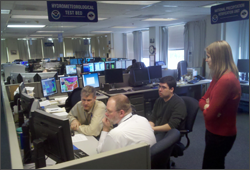
Participants evaluate forecasts of experimental model precipitation type during the HMT-HPC Winter Weather Experiment. (Photo by David Novak.)
|
The HMT-HPC 2011 Winter Weather Experiment
During the experiment, participants issued experimental snow and freezing rain forecasts for two 24-hour periods (Day 1 and Day 2). After completing the forecasts, participants were asked to write a forecast confidence discussion in which they detailed the uncertainties in the forecast, rated their overall confidence, and provided probabilities of a key winter weather event (such as snowfall greater than 4 inches) occurring at a location of interest. In addition to the experimental forecasts, participants subjectively evaluated the quality of the available model guidance for forecasting both snow and freezing rain accumulations as well as precipitation-type transitions.
The experimental NAM, which is scheduled to become operational in Spring 2011, was found to provide useful winter weather forecast guidance. A deficiency identified in the NCEP high-resolution window runs was that they often were too slow with the progression of the surface low. This impacted their precipitation and thermal forecasts, both of which are important for obtaining accurate forecasts of snow and freezing rain accumulations. The experiment also revealed the difficulty of deriving snow and freezing rain accumulations from the models, with significant differences sometimes observed between model-generated snow and freezing rain accumulations and techniques based on statistical algorithms.
An analysis of the forecast confidence discussions shows that snowfall forecasts rated as low (high) confidence by the forecast team tended to be associated with larger (smaller) forecast errors. The same relationship was not found for freezing rain forecasts, which might indicate forecasters are better able to anticipate forecast errors for snow accumulations than for freezing rain accumulations.
The HMT-HPC Winter Weather Experiment provided a unique opportunity to foster winter weather collaboration between participants from the research and operational forecasting communities. The issues discovered during the course of the experiment are being explored through collaboration with EMC. The HMT-HPC plans to build on these discoveries and the overall success of this year's experiment in 2012.